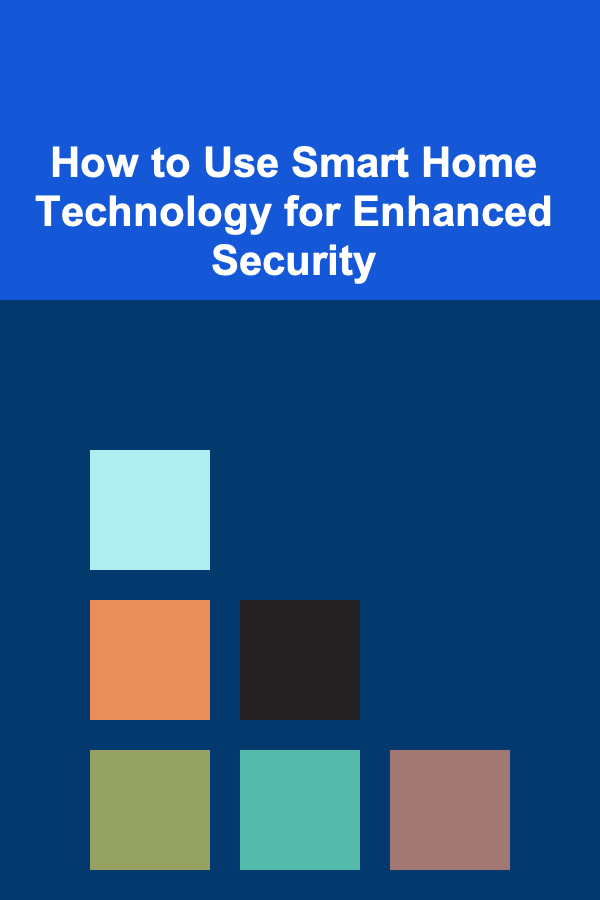
How to Use Smart Home Technology for Enhanced Security
ebook include PDF & Audio bundle (Micro Guide)
$12.99$10.99
Limited Time Offer! Order within the next:

In recent years, smart home technology has transformed the way we live, offering convenience, efficiency, and enhanced security. With the increasing prevalence of smart devices, homeowners can now leverage these technologies to create a safe and secure living environment. This article explores how to effectively use smart home technology for enhanced security, providing insights into various components, integration strategies, best practices, and future trends.
Understanding Smart Home Technology
2.1. Definition and Overview
Smart home technology refers to a network of devices and systems that communicate with each other and can be controlled remotely via the internet. These devices include everything from smart lights and thermostats to security cameras and locks. The primary goal is to enhance the functionality of a home, making it smarter, safer, and more efficient.
2.2. Benefits of Smart Home Technology
The benefits of smart home technology are extensive:
- Convenience: Automating routine tasks saves time and effort.
- Energy Efficiency: Smart devices optimize energy consumption, reducing utility bills.
- Enhanced Security: Smart security systems offer real-time monitoring and alerts.
- Remote Access: Homeowners can control their devices from anywhere, providing peace of mind.
Components of a Smart Home Security System
A robust smart home security system consists of various components that work together to protect your home. Here are the key elements:
3.1. Smart Cameras
Smart cameras provide surveillance capabilities with features such as:
- Live Streaming: View live feeds from your smartphone or computer.
- Motion Detection: Receive alerts when movement is detected.
- Two-Way Audio: Talk to visitors through the camera using your device.
3.2. Smart Locks
Smart locks enhance entry security by allowing keyless access. Key features include:
- Remote Locking/Unlocking: Control access from anywhere.
- Temporary Access Codes: Provide visitors with time-limited access.
- Activity Logs: Track who enters and exits your home.
3.3. Smart Sensors
Various sensors can be integrated into your security system:
- Door/Window Sensors: Alert you when doors or windows are opened.
- Motion Sensors: Detect movement in specific areas of your home.
- Environmental Sensors: Monitor conditions like smoke, carbon monoxide, and flooding.
3.4. Smart Alarms
Smart alarms combine traditional alarm functions with advanced technology:
- Real-Time Alerts: Notify you immediately of any security breaches.
- Integration with Other Devices: Work in conjunction with other smart devices for comprehensive protection.
Integrating Smart Home Devices for Security
To maximize security, integrating various smart devices is essential. Here's how to achieve that:
4.1. Centralized Control Systems
Using a centralized hub allows seamless control of all your smart devices. Hubs can connect multiple brands and types of devices, enabling unified management.
4.2. Voice Assistants
Voice assistants like Amazon Alexa, Google Assistant, and Apple's Siri can control your smart home devices. You can ask your assistant to lock doors, check camera feeds, or adjust security settings.
4.3. Mobile Apps
Most smart devices come with dedicated mobile apps. These apps allow you to monitor and control your devices remotely, providing real-time notifications and updates.
Creating a Comprehensive Smart Security Strategy
Developing a smart security strategy involves careful planning and execution. Here are the steps to consider:
5.1. Assessing Your Security Needs
Begin by evaluating your home's vulnerabilities:
- Identify entry points (doors, windows).
- Consider the layout of your property.
- Determine any high-risk areas (garages, basements).
5.2. Choosing the Right Devices
Select devices that meet your specific security needs. Consider factors such as:
- Size of your home.
- Number of entry points.
- Budget constraints.
5.3. Implementing Automation
Automation enhances your security strategy by creating routines. For example:
- Set cameras to record only during specific hours.
- Program lights to turn on/off at designated times.
- Create alerts for unusual activity based on predefined parameters.
Best Practices for Smart Home Security
To ensure the effectiveness of your smart home security system, follow these best practices:
6.1. Secure Your Network
Your smart devices rely on your home Wi-Fi network. Protect it by:
- Changing default passwords.
- Using strong, unique passwords for each device.
- Enabling network encryption (WPA3 if available).
6.2. Regular Updates and Maintenance
Keep your devices updated to protect against vulnerabilities. Manufacturers often release firmware updates to address security issues; ensure your devices receive these updates promptly.
6.3. User Education
Educate all household members about the smart security system. Ensure they understand how to use the devices and recognize potential security threats.
Case Studies: Successful Implementations
7.1. Residential Applications
Many homeowners have successfully implemented smart home technology for enhanced security. For instance, the Smith family installed a comprehensive system featuring smart locks, cameras, and sensors. They reported feeling significantly safer knowing they could monitor their home remotely and receive instant alerts.
7.2. Small Business Applications
Small businesses have also benefited from smart security solutions. A local café integrated smart cameras and alarms, allowing the owner to monitor activities during off-hours. The ability to review footage remotely provided peace of mind, leading to increased security and reduced theft incidents.
Future Trends in Smart Home Security
The smart home security landscape is continually evolving. Here are some trends to watch for:
- Artificial Intelligence: AI-driven surveillance systems will analyze behavior patterns to distinguish between normal and suspicious activities.
- Integration with IoT: As the Internet of Things (IoT) expands, more devices will connect, creating a more cohesive security ecosystem.
- Biometric Security: Fingerprint and facial recognition technology will enhance authentication methods for devices and entry systems.
Conclusion
Leveraging smart home technology for enhanced security is not just a trend; it's a necessity in today's world. By understanding the components of a smart security system, integrating various devices, and following best practices, homeowners can create a safe and secure living environment. With ongoing advancements in technology, the future of smart home security looks promising, offering even greater protection and convenience. Adopting these technologies is an investment in the safety and security of your home and loved ones.
Reading More From Our Other Websites
- [Home Budget Decorating 101] How to Use Houseplants to Decorate Your Home Affordably
- [Polymer Clay Modeling Tip 101] Beginner's Guide: Essential Polymer Clay Hacks Every Crafter Should Try
- [Organization Tip 101] How to Implement a Paperless Office System
- [Personal Care Tips 101] How to Care for Your Skin with a Simple Routine
- [Paragliding Tip 101] Helmet Head-to-Head: Reviewing the Most Reliable Protective Gear for Pilots
- [Organization Tip 101] How to Keep Important Documents Organized as a Family
- [Home Rental Property 101] How to Set Competitive Rent Prices for Your Property
- [Home Lighting 101] How to Transform Your Backyard into a Paradise: Pool Lighting Installation & Design
- [Home Renovating 101] How to Perform DIY Plumbing Repairs for Common Issues
- [Personal Finance Management 101] How to Build Multiple Income Streams to Improve Financial Stability

How to Choose Eco-Friendly Options for Your Home Renovation
Read More
How to Invest in Bonds for Steady Returns and Lower Risk
Read More
Mastering Interior Design: A Comprehensive Approach for Interior Decorators
Read More
Mastering the Wok: A Comprehensive Guide to Wok Cooking
Read More
Mastering 3D Printing for Stop-Motion Animation
Read More
How to Choose the Right Golf Club for Your Handicap
Read MoreOther Products

How to Choose Eco-Friendly Options for Your Home Renovation
Read More
How to Invest in Bonds for Steady Returns and Lower Risk
Read More
Mastering Interior Design: A Comprehensive Approach for Interior Decorators
Read More
Mastering the Wok: A Comprehensive Guide to Wok Cooking
Read More
Mastering 3D Printing for Stop-Motion Animation
Read More